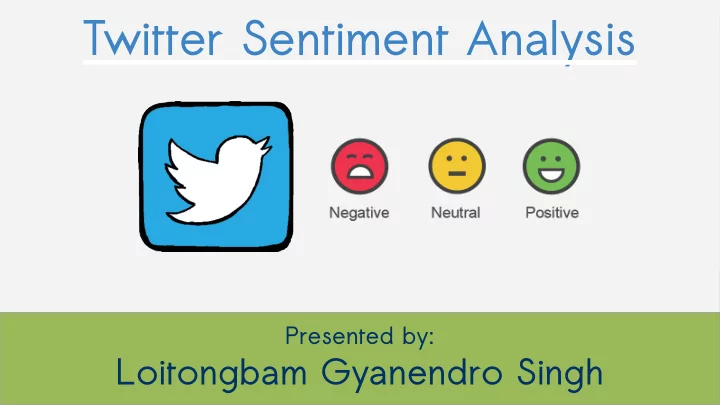

Twitter Sentiment Analysis Twitter Sentiment Analysis Presented by: Loitongbam Gyanendro Singh
What is “Sentiment analysis”? ● Study that aims to identify the orientation of opinions in a text
Source of Sentiment Information Source of image: http://jameskaskade.com/?p=2336
Why Sentiment Analysis? Advent of various social media platforms ➔ Given netizen the liberty to openly express their views and opinions ➔ Large volume of data to get these information ➔ Knowing “ what people think ” ➔ Studies of SA deals: Product and services reviews, ◆ Celebrities, ◆ OM: Study the subjectivity of opinion Government policies, ◆ SA: Study the sentiment of opinion Event, ◆ and many more… ◆
Opinion ➔ An opinion is quintuple: (Bing Liu, 2012) ◆ (e i ,a ij ,s ijkl ,h k ,t l ) ➔ Example: The picture quality of my new Nikon V3 camera is great ◆ (Nikon V3, picture quality, positive, User, Time) ◆ ➔ Where can we fjnd opinionated text? Blogs ◆ Microblogs ◆ Consumer forum/sites, etc. ◆
Microblogs ➔ Microblogs contains a large amount of opinionated text ➔ There are many microblogging platforms available Twitter ◆ Tumbler ◆ FourSquare ◆ Google+ ◆ LinkedIn ◆ ➔ Twitter provides an easy way to access and download published posts
Microblogs ➔ Microblogs contains a large amount of opinionated text ➔ There are many microblogging platforms available Twitter ◆ Tumbler ◆ FourSquare ◆ Google+ ◆ LinkedIn ◆ ➔ Twitter provides an easy way to access and download published posts
Twitter Sentiment Analysis ➔ Majority of TSA studies deals on building sentiment classifjer
TSA challenges ➔ Text length ➔ Topic relevance ➔ Noisy text ➔ Data sparsity ➔ Negation ➔ Stopwords ➔ Tokenization ➔ Multilingual content ➔ Multimodal content
Features Opinion words, Sentiment words, ➔ Semantic Semantic concepts, ➔ Syntactic Negation, etc. ➔ Stylistic ➔ Twitter specifjc features
Features Unigrams, Bigrams, ➔ Semantic N-grams, ➔ Syntactic Terms’ frequencies, ➔ Stylistic POS, ➔ Twitter specifjc features Dependency tree, etc
Features ➔ Semantic Emoticons, ➔ Syntactic Intensifiers, ➔ Stylistic Abbreviations, ➔ Twitter specifjc features Slang terms, Punctuation marks, etc.
Twitter Specifjc Features ➔ Tweet ➔ User ➔ Mention ➔ Replies ➔ Follower ➔ Retweet ➔ Hashtag ➔ Privacy
Features Selection ➔ Manual selection ➔ Statistical analysis ➔ Dimensionality reduction ➔ Representation learning
Statistical Approach ● Entropy, H(X) = - ∑ i ○ ∈ [P(x i ) * log(P(x i ))] C ● Strength of Association via Pointwise Mutual Information , PMI(x,S) = log(P(x,S)/{P(x)*P(S)}) ○ SOA(x,S) = PMI(x,S) - PMI( x,S) ○ ⅂
Latent Representation Methods ● Eigen Value Decomposition (EVD) ● Singular Value Decomposition (SVD) ● Word Embedding via Word2Vec, etc.
Classifjcation Approach ➔ Machine Learning ➔ Lexicon-based ➔ Hybrid-based
DNN Classifjcation approach d = embedding dimension Convolution Neural Network m = window size s = max length n = no. of filters Paper Title: Twitter Sentiment Analysis with Deep Convolutional Neural Networks - Aliaksei Severyn and Alessandro Moschitti
Evaluation Metrics ➔ Accuracy ➔ Precision ➔ Recall ➔ F-score
Related fjelds ● Twitter-based Opinion Retrieval ● Tracking Sentiment over Time ● Irony Detection on Tweets ● Emotion Detection on Tweets ● Tweet Sentiment Quantifjcation
References ● Like It or Not: A Survey of Twitter Sentiment Analysis Methods (Authors: Anastasia Giachanou, Fabio Crestani) ● Sentiment Analysis and Opinion Mining (Author: Bing Liu) ● Google ● Twitter
Thank you
Recommend
More recommend